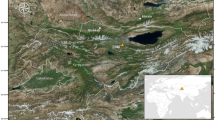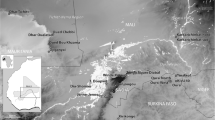Abstract
In the Late Pre-Roman Iron Age an underground granary in the village of Overbyg»rd was destroyed by fire and the contents were carbonised. Almost 2000 years later, analyses of the macroremains of the granary, which included a range of processed and unprocessed crops and weed seeds, showed that naked barley (Hordeum vulgare var. nudum) and bread wheat (Triticum aestivum s.l.) were the main crops cultivated, hulled barley (Hordeum vulgare) and flax (Linum usitatissimum) also played a role, whereas emmer (Triticum dicoccum) and gold of pleasure (Camelina sativa) were present as weeds or contaminants. The arable weed flora suggests that crops were sown in spring and that ecological conditions in the arable fields were very variable. The crops were harvested on the straw and may have spent some time drying and maturing in the fields before being transported home to be stored as severed ears in pest-proof granaries. Winnowing or, more probably, casting appears to have been used to clean the crop after threshing. It could not be ascertained if the crops had been sieved. Large collections of weed seeds in the granary were apparently the result of intentional gathering for food, rather than by-products of crop processing. In the light of the investigation it is suggested that future research into Iron Age agrarian practices should include both the analysis of archaeobotanical finds and a programme of practical experiments. This dual approach will give us a much better understanding of arable agriculture, not only in the Iron Age, but in prehistory as a whole.
Similar content being viewed by others
References
Andersen S (1983) Kulturplanterne [Crop plants]. DSR-forlag, Copenhagen
Behre KE (1976) Die Pflanzenreste aus der frühgeschichtlichen Wurt Elisenhof. Stud Küstenarchäol Schleswig-Holsteins, Serie A, 2: 1–183
Behre KE (1983) Ernährung und Umwelt der wikingerzeitlichen Siedlung Haithabu. Die Ergebnisse der Untersuchungen der Pflanzenreste. Wachholtz, Neumünster
Engelmark R (1989) Weed seeds in archaeological deposits. Models, experiments and interpretations. In: Larsson TB, Lundmark H (eds) Approaches to Swedish prehistory. BAR, International Series 500, Oxford, pp 179–187
Hansen K (1981) Dansk feltflora [Danish Excursion Flora]. Gyldendal, Copenhagen
Hatt G (1938) Jernalders bopladser i Himmerland [Iron Age settlement in Himmerland]. Årbøger Nord Oldkyndighed Hist 1938: 199–266
Helbæk H (1954) Prehistoric food plants and weeds in Denmark. A survey of archaeobotanical research 1923–1954. Dan Geol Unders, Series II, 80: 250–261
Helbæk H (1957) Bornholm plant economy in the first millennium A.D. In: Bornholm i folkevandringstiden. Nationalmuseets Skrifter, Større Beretninger 2: 259–277
Helbæk H (1958) The Oxbøl grain. Acta Archaeol 29: 155–157
Helbæk H (1974) The Fyrkat grain. A geographical and chronological study of rye. In: Olsen O, Schmidt H (eds) Fyrkat. En jysk vikingeborg [Fyrkat. A Viking stronghold in Jutland]. Nord fortidsminder, Series B, 2: 1–41
Henriksen PS (1992) Jernalderens landbrug beskrevet ud fra arkæologiske frøfund [Iron Age agriculture based on archaeobotanical finds]. Nationalmus Naturvidensk Unders 20: 1–16
Henriksen PS, DE Robinson (in press) Archaeobotany as a source of information about past agrarian practices. In: Mejdahl V (ed) Proceedings of the sixth Nordic conference on the application of scientific methods in archaeology. Esbjerg, 1993. Esbjerg Museum, Esbjerg
Hillman G (1981) Crop husbandry from charred remains. In: Mercer R (ed) Farming practice in British prehistory. University Press, Edinburgh, pp 123–162
Hillman G (1984) Interpretation of archaeological plant remains: the application of ethnographic models from Turkey. In: van Zeist W, Casparie, WA (eds). Plants and ancient man. Balkema, Rotterdam, pp 1–41
Jones G (1984) Interpretation of archaeological plant material. Ethnographic models from Greece. In: van Zeist W, Casparie MA (eds) Plants and ancient man. Balkema, Rotterdam, pp 43–61
Jones G (1987) A statistical approach to the archaeological identification of crop processing. J Archaeol Sci 14: 311–324
Jones M (1988) The arable field: a botanical battleground. In: Jones M (ed) Archaeology and the flora of the British Isles. Oxford University Committee for Archaeology, Oxford, pp 86–92
Jørgensen G (1976) Et kornfund fra Sarup. Bidrag til belysning af tragtbægerkulturens agerbrug [A grain find from Sarup. A contribution to the understanding of agriculture of the Funnel Beaker culture]. Kuml 1976: 47–64
Jørgensen G (1985) Korn. I Steen Hvass: Hodde. Et Vestjysk landsbysamfund fra ældre jernalder [Hodde: a village society from the Early Iron Age in western Jutland]. Akademisk Forlag, Volume 83, Copenhagen
Juel Jensen H (1994) Flint tools and plant working. Hidden traces of Stone Age technology. Århus University Press, Århus
Korsmo E, Vidme T, Fykse H (1981) Korsmos ugrasplansjer [Korsmos weed tables]. Landbrugsforlaget, Oslo
Körber-Grohne U (1967) Geobotanische Untersuchungen auf der Feddersen Wierde. Feddersen Wierde, Band 1. Steiner, Wiesbaden
Kroll H (1987) Vor- und frühgeschichtlicher Ackerbau in Archsum auf Sylt. Eine botanische Großrestanalyse. In: Kossack G (ed) Archsum auf Sylt. Teil 2. Landwirtschaft und Umwelt in vorund frühgeschichtlicher Zeit. Röm.-Germ. Forsch. 44: 51–158
Lund J (1978) I en kælder... [In a cellar...]. Skalk 1978(1): 3–10
Lund J (1979) Tre førromerske jordkældre fra Overbyg»rd [Three Iron Age cellars from Overbyg»rd]. Kuml 1979: 109–139
Robinson D (1994) Kulturplanter fra Danmarks forhistorie [Crop plants in Danish prehistory]. Arkæologiske udgravninger i Danmark 1993. Det Arkæologiske Nævn, Copenhagen
Robinson DE, Boldsen I (1991) Et eksperiment til belysning af jernalderens kornbrug [An experiment in Iron Age agriculture]. In: Madsen B (ed) Eksperimentel Arkæologi. Studier i teknologi og kultur [Experimental archaeology. Studies in technology and culture] Historisk-Arkæologisk Forsøgscenter, Lejre, 83–89
Robinson DE, Michaelsen KK (1989) Early Viking Age carbonised plant remains from Ejstrup, Vendsyssel, Danmark. Acta Archaeol 59: 223–228
Robinson DE, Mikkelsen PH (1994) Arkæobotaniske undersøgelser af forhistoriske bopladser [Archaeobotanical analysis of prehistoric settlement sites]. Arkæologiske udgravninger i Danmark 1993. Det Arkæologiske Nævn, Copenhagen
Robinson DE, Siemen P (1988) A Roman Iron Age funerary deposit from Præstestien, southwestern Jutland, and the early cultivation of rye in Denmark. Antiquity 62: 697–704
Rowley-Conwy P (1984a) A new sample of carbonized grain from Voldtofte. Kuml 1982–83: 147–152
Rowley-Conwy P (1984b) The Egehøj cereals. J Dan Archaeol 3: 104–110
Van der Veen M, Fieller N (1982) Sampling seeds. J Archaeol Sci 9: 287–298
Wasylikowa K (1981) The role of fossil weeds for the study of former agriculture. Z Archäol: 15 11–23
Author information
Authors and Affiliations
Rights and permissions
About this article
Cite this article
Henriksen, P.S., Robinson, D. Early Iron Age agriculture: archaeobotanical evidence from an underground granary at Overbyg»rd in northern Jutland, Denmark. Veget Hist Archaebot 5, 1–11 (1996). https://doi.org/10.1007/BF00189430
Received:
Accepted:
Issue Date:
DOI: https://doi.org/10.1007/BF00189430




